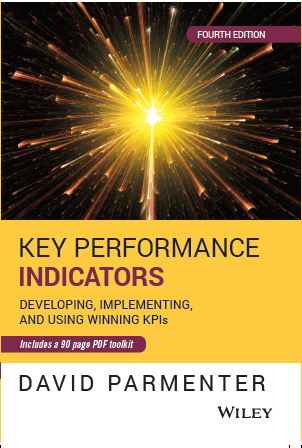Your cart is currently empty!
Area of mastery – KPI
“Show me a company with over 20 KPIs and I will show you lack of focus, lack of alignment and under achievement.”
For years organisations that have measured and reported what they thought were KPIs have not had the focus, adaptability, innovation and profitability that they were seeking. KPIs themselves were mislabelled and misused. Some organizations try and manage with over forty KPIs, many of which are not KPIs.
David Parmenter has brought to light three discoveries to unlock performance measures from their shackles.
1. An organization operating without its critical success factors, known by all staff, is aimless.
2. Most measures are not, in fact, KPIs. They are result indicators — measures that show how teams have worked together, often measured monthly, leading to a busy reporting machine that fails the organization.
3. All KPIs are non-financial, measured 24/7, daily or at the very least, weekly.
KPI implementation guides (150 Page Whitepaper + e-templates)
David Parmenter’s KPI implementation guides (whitepaper and accompanying electronic media) contains up-to-the-minute research and discoveries. The KPI implementation guides have been significantly updated in February 2024. There are three options based on the size of your organization (Less than 100 FTEs, 100- to 250 FTEs and over 250 FTEs).This unique implementation guide is a comprehensive paper (150 pages), designed to help readers implement the Winning KPI methodology. The implementation guide comes with E-templates, eg: formats, templates, draft PowerPoints, and workshop templates to assist in swift implementation. In addition, the templates from the 4th edition of the KPI book are also included.
I have spent around US$30,000 developing and updating this implementation guide. I guarantee, you will save many times the cost of the implementation guide. The KPI implementation guide includes my latest thinking before it is printed and dispatched to you.
Free E-templates to readers who post a review
If you have already read the KPI book and are prepared to write a 100 -150 word review I will send you free of charge the templates from the book as long as the review is lodged on Amazon and goodreads. Please email me as soon as this is done using parmenter [at] waymark [.] co [.] nz
How do you start a KPI project?
You will need to:
1. “Are you ready for a KPI project?”(Relink)
You first need be fully aware what is involved. Complete my checklist “Are you ready for a KPI project”.
Read David’s chapters on The Great Misunderstanding with regard to KPIs and the myths of performance measurement.
3. How I can help get the C-suite committed (Relink)
If you have an executive retreat, why not fly me out, business class, to deliver my KPI methodology? We would need four to five days. The first two I would lead and then come back on day five after I had processed the workshop content. My last venue was the ski resort ‘Whistler’.
2. Learn how to lead and sell change from the experts (Relink)
Start creating the burning platform in the minds of the C-suite and the organization’s oracles. Read David’s chapter on Leading and Selling Change.
Plan your approach by reading my KPI implementation guide, and purchasing my KPI implementation guides package.
4. Selecting and training the KPI team (Relink)
Once you have selected a KPI team, if you have done your homework, I will put down my golf clubs and deliver an in-house webcast to help train the KPI team for you.
Start the journey by ascertaining the organization’s critical success factors. I can support you from afar through GoToMeeting or phone calls.
Winning KPI webinar training delivered by David Parmenter
David Parmenter has designed a Winning KPI webinar-based training programme so he can deliver KPI training to the in-house KPI team and staff remotely. He will only get involved if he has first had a telephone / WhatsApp call with the CEO.
Part 1: Train the KPI team, deliver three 2.5 hour webinars and handover for the KPI team to deliver the two remaining webinars. Delivering pretraining and the web-based training programme (3 sessions) is about 5-6 days of work for me. It involves:
- Liaison time with the KPI team
- Reviewing background materials
- Preparation of presentations
- Video meetings with SLT as required
- Preparing materials using your company’s content for the webinars
- Detailed review of the first cut CSFs
- Reviewing content generated by webinars in time for the next session
- Use of my IP
Part 2: Further support to the KPI team. Further KPI team support would include:
- Weekly meetings for the duration of the active stages project
- On-call to answer questions that are holding up progress
- Detailed review of the final draft of the critical success factors.
- Assistance with the preparation of the slides for the presentation of the CSFs to staff
- Detailed review of the final performance measures.
LEARN MORE
| What are KPIs: |
| Selling a KPI project: |
| Starting a KPI project: |
| Getting help with your KPI project: |
| Reporting performance measures: |
What is a Key Performance Indicator (KPI)?
Key Performance Indicators (KPIs) are those indicators that focus on the aspects of organisational performance that are the most critical for the current and future success of the organisation. KPIs have seven characteristics, which are explained in Chapter 1 KPI-book 4th edition “The Great Misunderstanding”. It is a myth to consider all performance measures to be KPIs. There are, in fact, four types of performance measures. There will only be about 8 – 10 KPIs in an organisation. For more information, also read Chapter 2 from the KPI book 4th edition ” The myths of performance measurement”.
KPIs are more than just a management and leadership catchphrase. The right KPIs, properly deployed, can transform your organisation – creating the kind of competitive advantage that delivers greater profitability and bigger bonus pools. The last two decades spent consulting and speaking to global enterprises and audiences in 31 countries and writing four books on the impact of KPIs, has convinced me that no other single management tool delivers more profound and positive organisational change. My winning KPIs are chosen and designed to cut through and sweep away management practices and performance issues that clog daily operations.
By adopting, embracing and implementing my winning KPIs, you can expect:
- Advanced operational performance and better job alignment invariably leading to a happier customer
- More clearly defined critical success factors and related performance measures resulting in a competitive advantage
- An up-welling of innovation throughout your enterprise
- A better managed organisation dedicated to best practice performance
- To attract, recruit and retain the right people.
The problem with KPIs
Key performance indicators (KPIs), while used commonly around the world, have never until now been clearly defined. Management personnel have identified measures as KPIs though these measures have never been KPIs. The lack of understanding of performance measures has led most monitoring and reporting of measures to fail. The casualty has often been the balanced scorecard, a brilliant tool that can only work if the appropriate measures are in it.
You need to know what is a KPI ? The seven characteristics of a KPI, and if most of your measures are not KPIs, what are they? Purchase my KPI implementation guides, which is my latest work and comes with electronic templates.
Accessing David Parmenter’s intellectual property
Here are three chapters for you to assess the value of this new edition. I can guarantee you will never look and use KPIs in the same way again. This book has further simplified my work and I fervently hope that it speeds up the desire to use and implement of winning KPIs.
Chapter 1 KPI-book 4th edition “The Great Misunderstanding”.
Chapter 2 KPI book 4th edition ” The myths of performance measurement”.
Click this link to look inside the new 4th edition and order from Amazon
Delivering the two-day CSF workshop as a 5 *2.5 hour webinar series
I can deliver my two-day CSF workshop as a 5 *2.5 hour webinar series for you. The two day workshop is a vital step in a KPI project and this is a less expensive way of getting some rubber on the road. Click here to enquire more about this option.
KPI and CSF implementation guides with E-templates (currently on a special offer)
If you want to access the latest thoughts of David Parmenter, buy his KPI and CSF implementation guides which are constantly updated and are a comprehensive (100 page) guide to get you to make change in the areas covered. each implementation guide comes with accompanying electronic templates to get your implementation started. On time of acquisition David reviews and updates the toolkit as appropriate. These implementation guides are printed, signed and posted to the purchaser.
David Parmenter’s implementation guides (currently on a special offer)
For areas which are not covered by a implementation guide David Parmenter has written a shorter (20- 30 pages) expert articles to help you make progress. They can be read and absorbed in an hour. All you need to do is purchase them via the PayPal link and I will email you the implementation guide with the accompanying useful E-templates within 48 hours. To buy multiple guides access the special deal.
E-Templates From David Parmenter’s best selling KPI book (currently on a special offer)
You can purchase all the electronic versions of the KPI book templates. Once the paypal notification has been received the templates are emailed with 48 hours.
David Parmenter’s performance measures database (currently on a special offer)
The database, developed over the last twenty years, and regularly updated, is sent in both Access and Excel. In my KPI book, I have always provided a list of performance measures to help to start or rejuvenate a KPI project. To purchase the latest version of this Performance Measures database costs US$99. This database helps a team manage the balanced scorecard perspectives, enables all the organisation’s teams to select their performance measures, contains a checklist of success factors by major sectors and sets over 400 measures to help with the selection process. The database contains an easy ‘add to’ feature so existing measures can be added. The database, if used correctly, will ensure that all measures are sourced from a critical success factor in an organisation. Buy it and get started tomorrow!
Dear David,
UK Food Manufacture with 4,000 FTEs with Factories in 10 Locations
I was specifically concerned with the business’s sole focus on short-term outputs, as opposed to medium- and long-term inputs, which I saw as predictors of future performance. I was also concerned at the lack of teamwork and confusing terminology (in-company slang), which created division, confusion, and a bit of a blame culture. Needing some inspiration, I read up on business improvement theory and came across David’s work.
We asked a senior manager to lead the change program working with, and mentored by, David. This took the form of a series of sessions where the manager and David, working with a number of key stakeholders, participated in a small number of workshops and project planning meetings, the culmination of which was a full rollout of the KPI methodology across the business.
David, using webinar technology, was able to deliver the training in 2.5-hour sessions to multiple locations simultaneously, with breakout sessions where groups could germinate, share, and develop their ideas. The webinar sessions helped garner buy-in from the executives and helped deliver results quickly.
Alongside this steering group, we established a KPI team to do the heavy lifting and to ensure the intent was cemented into daily working patterns. This KPI team remains today, providing the entire business with KPI reporting on a daily basis.
I would recommend this methodology to all CEOs who are seeking to more easily see the granular performance of their business. We’ve moved from being a backward-looking business, where teams politick and mark their own homework, to a more lithe and forward-looking company with live and objective reporting that guides us to focus on the things that are important and we can control.
Mike Snell, Managing Director, IPL
-David Stuart, Finance DirectorHolker Group


